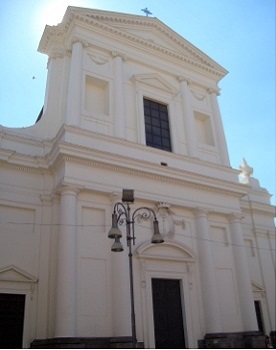The work started in 1781 under the supervision of two brothers Giulio and Giuseppe Camporese, the latter considered the main artist of the Collegiate. It was consecrated in 1808.
The façade recalls the 16th century Roman style: it is tripartite with a higher central body and two overlapping orders, the lower Tuscan and upper Ionic. The portal, framed between two columns has an arched tympanum resting on consoles bearing the emblem of Genzano. In the upper part, we can see four columns supporting the tympanum with a jagged frame, and a central rectangular window with two side symmetrical niches.
At the sides of the building, there are two external buttresses one supporting the nave and the other the wall of the transept. On the right is a bell tower decorated with single windows, rebuilt in the early 20th century after the demolition of the original one.
The inside has a Latin cross layout. Between the second and third arch of the central nave, on the left, there is a wooden carved pulpit with a central golden figure relief of Consegna della regola di San Benedetto da Norcia (consigning of the Rules of St. Benedict of Nursia). The fourteen images, representing the stations of the Via Crucis, standing between the central nave and the transept come from Santa Maria della Cima.
The dome and four large pendentives, with an Evangelist figure on each one, rest on pilaster strips; the painted strips match those of the façade. Above, some lunette windows open out between one vault and another. Entering the church from the right hand door outside, are four small rectangular chapels along the right hand corridor. Each one has an altar and is decorated with pictures or statues.
Inside the first chapel, dedicated to Sant’Antonio di Padova, the pendentives illustrate the four cardinal virtues (Prudence, Courage, Justice, Temperance). The second chapel, dedicated to Santa Rita da Cascia , was rebuilt after damages during the Second World War. In the third chapel there is a picture portraying San Tommaso di Villanova, copy of the canvas by Murillo conserved at the Museum of Fine art of Seville; previously there was a very beautiful canvas representing a miracle by San Vincenzo Ferreri (17th century), which was moved from this chapel to the Sacristy. The last chapel along the right hand corridor, dedicated to Our Lady of Sorrows, has an altar with a small neoclassic temple on four ionic columns and a low ceiling where the choir stalls were placed. In the apse, beyond the chancel and the high altar, there is a large oil painting of the 19th century by the painter Apparisio, representing the Holy Trinity with Christ on the left, God the Father on the right and the Holy Spirit as a dove. Above the altar with the balustrade on the right side of the transept, you can see four golden statues, excellent examples of fine gold art towards the end of the 18th century (half bust figures of San Sebastiano, San Tommaso di Villanova, Sant’Emidio and San Vincenzo Ferrerri). There is also a tabernacle from the end of the 18th century and a large canvas of the Madonna di Monferrato. In the altar with the balustrade on the left side of the transept, is a wooden tabernacle from the 19th century with a built-in wardrobe on the right side containing relics and various shrines, as well as a large canvas of Santa Margherita Maria Alacoque of the 20th century.
The small chapels on the left are similar to those on the right. In the first, a monochrome fresco of the Battesimo di Cristo (Baptism of Christ) by Pietro Tedeschi (19th century). In the second, an image of the Madonna with her hands together in a sun-like frame (end of the 18th century); also two frescoes representing Vicende di Sisara e Debora, Giuditta e Oloferne (Biblical episodes of Sisera and Deborah, Judith and Holofernes) typical of the neoclassic period. In the last two chapels, dedicated respectively to the Crocifisso and to Saint Joseph, there are floral and geometric decorations of the 19th century.


 Visit Castelli Romani
Visit Castelli Romani 

